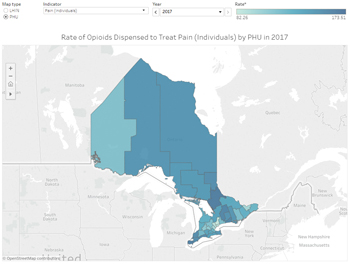Monitoring opioid prescriptions across Ontario

By Mary Dickie

Dr. Tara Gomes
Scientists at the Ontario Drug Policy Research Network have unveiled an interactive tool that shows opioid prescription rates across the province, enabling users to quickly evaluate the impact of programs designed to deal with the opioid crisis. It will add to the data collected by a similar tool developed by Public Health Ontario (PHO) that measures opioid-related harms across the province.
“The PHO tool has been really helpful for monitoring opioid outcomes,” explains Dr. Tara Gomes, a scientist at the Li Ka Shing Knowledge Institute. “However, we continue to receive requests related to how opioids are being prescribed, and whether they’re being prescribed at high dosages. In particular, organizations are looking for up-to-date information in their regions to help guide the development of new programs that can respond to this crisis.”
The new tool captures all opioids dispensed across Ontario that are used to treat pain, cough and addiction, using data gathered by the province’s Narcotics Monitoring System and analyzed at the Institute for Clinical Evaluative Sciences. The information posted includes the number of people treated, the types of opioids dispensed, the degree of high dose prescribing, and accessibility to physicians who prescribe opioids to treat addiction.
“Using this new data, we can see how the rate of opioid prescribing for pain management has decreased in recent years, while the rate at which these medications are prescribed to treat an opioid use disorder or addiction is increasing,” says Dr. Gomes. “This speaks to an important trend towards fewer opioids going out into the community and more people accessing treatment for an opioid use disorder. Although these trends are generally consistent across the province, the patterns differ in some regions, which can be very informative at the local level.”
Dr. Gomes is careful to point out the importance of contextualizing this information within the broader, shifting opioid environment, and not jumping to the conclusion that a drop in prescriptions is always desirable. “We hope that attempts to promote appropriate opioid prescribing will ultimately lead to lower opioid prescribing rates,” she says. “But we don’t want to see large reductions in opioid prescribing that could be suggestive of doctors cutting patients off from their pain medication. Instead, when reducing someone’s dose is appropriate, we should aim for gradual, safe dose tapering.”
The tool is accessible to the public, and Dr. Gomes expects it to have thousands of users. “We want to make it available to as many people as possible,” she says. “We will be monitoring its use, and seeking opportunities for feedback so that we can continuously improve the information provided to ensure that it addresses the needs of all its users.”
The data is downloadable, giving people – including those working in public health units, Local Health Integration Networks and other groups monitoring this issue at the local or provincial level – the ability to create their own figures and merge this information with other data sources.
“We’ve specifically designed this tool to be consistent with Public Health Ontario’s reporting of outcomes,” says Dr. Gomes. “We hope this will allow people to combine the opioid prescribing data and the outcomes data to broaden the picture of the changing opioid environment across Ontario.”
About St. Michael’s Hospital
St. Michael’s Hospital provides compassionate care to all who enter its doors. The hospital also provides outstanding medical education to future health care professionals in more than 29 academic disciplines. Critical care and trauma, heart disease, neurosurgery, diabetes, cancer care, care of the homeless and global health are among the Hospital’s recognized areas of expertise. Through the Keenan Research Centre and the Li Ka Shing International Healthcare Education Centre, which make up the Li Ka Shing Knowledge Institute, research and education at St. Michael’s Hospital are recognized and make an impact around the world. Founded in 1892, the hospital is fully affiliated with the University of Toronto.

